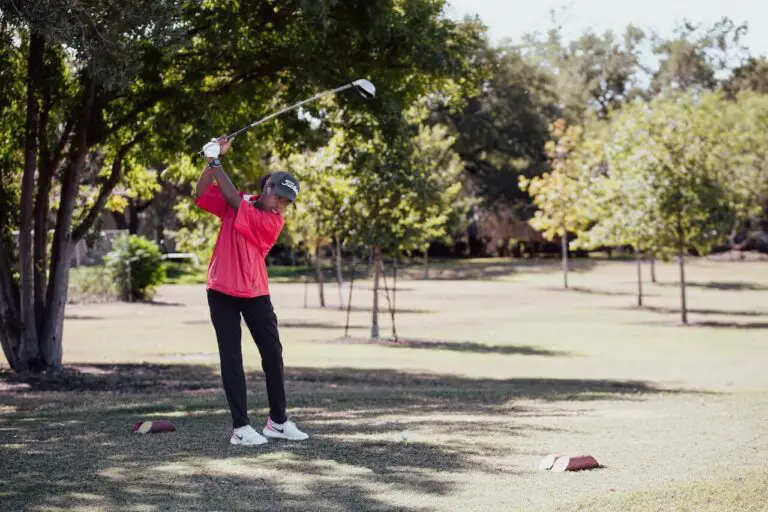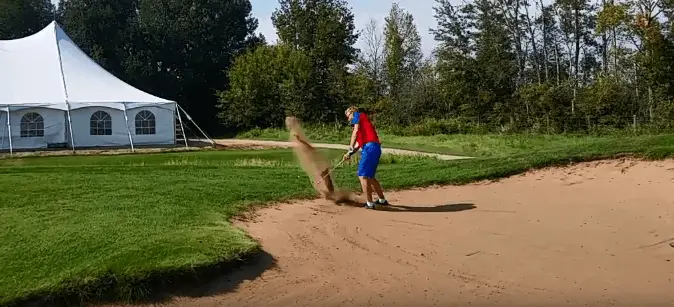Golf Simulator Buyer’s Guide – Know Before You Buy

Here is our buyer’s guide for information related to purchasing a golf simulator for your home or business.
What Is A Golf Simulator?
Basically, it’s a way to play golf virtually using your own clubs and balls while staying in the comfort of your own home or garage. Golf simulators have sensors and tracking tech that measure your swing and calculate the speed, trajectory, and distance of your shots, as well as a projection system that displays realistic golf course gameplay on a screen.
Golf simulators use ball and club tracking software to mimic the physics of a real golf swing to give you an accurate and realistic experience. Most simulators come with virtual practice ranges, putting greens, and golf instruction programs too.
⛳ CHECK OUT OUR TOP GOLF SIMULATOR PICKS: Best Golfing Simulators: Find Your Best Golf Simulator for 2023
Best Reasons To Buy A Golfing Simulator
Here are a few reasons why a golf simulator might be a good fit for you.
✔️ Practice and improve your game
✔️ Play virtual rounds of golf
✔️ Save time and money
✔️ Play golf in any weather
✔️ Host golf-themed events
✔️ Play golf at any skill level
✔️ Customize your game
✔️ Enjoy the social aspect of golf
✔️ Stay active
✔️ Enhance your golf travel experience
What Are The Types of Golf Simulators?
Here are the main types of golf simulators.
Launch monitors
Launch monitors are portable, lightweight devices that measure the speed, trajectory, and distance of your shots using sensors and tracking technology. They are typically used for practice and training, and can be set up in a variety of locations, including driving ranges, indoor golf facilities, or even your own backyard.
Home golf simulators
Home golf simulators are designed for use in residential settings, and are typically smaller and more compact than commercial simulators. They often come with a projection system and software that allows you to play virtual rounds of golf on a variety of courses.
Commercial golf simulators
Commercial golf simulators are designed for use in dedicated golf facilities or indoor golf centers. They tend to be larger and more expensive than home simulators, and often have more advanced features and capabilities.
Full-swing simulators
Full-swing simulators are designed to replicate the full range of motion of a golf swing, from the takeaway to the follow-through. They typically use sensors and tracking technology to measure the speed, trajectory, and distance of your shots, and provide real-time feedback on your swing.
Putting simulators
Putting simulators are designed specifically for practicing and improving your putting skills. They use sensors and tracking technology to measure the speed, direction, and break of your putts, and provide real-time feedback on your stroke.
How Do Golf Simulators Work?
Golf simulators work by using a combination of sensors, tracking technology, projection systems, and software to replicate the physics of a real golf swing and ball flight. Here’s a breakdown of how they work:
- Sensors and tracking technology: Golf simulators use sensors and tracking technology to measure the speed, trajectory, and distance of each shot.
- Projection systems: Golf simulators use projection systems to display a realistic 3D rendering of a golf course on a screen or wall.
- Software and simulation programs: Golf simulators use software and simulation programs to process the data collected by the sensors and projection system and generate a realistic and accurate representation of the golf course and ball flight.
⛳ Golf Simulator Key Decision Factors
When shopping for a golf simulator, there are several key considerations to keep in mind. Here are a few things to think about:
- Space: Golf simulators come in a variety of sizes and shapes, and some require more space than others. Consider the size of the room or area where you plan to set up your simulator and make sure you have enough room to accommodate the simulator and any additional equipment or accessories.
- Budget: Golf simulators range in price from a few hundred dollars to several thousand dollars, depending on their features and capabilities. Determine your budget before shopping, and look for a simulator that meets your needs and fits within your budget.
- Accuracy: Golf simulators use sensors and tracking technology to measure the speed, trajectory, and distance of your shots. Some simulators are more accurate than others, so it’s important to consider the level of accuracy you want.
- Software options: Golf simulators come with a variety of software options, including practice ranges, putting greens, and golf instruction programs. Consider what types of software you want and need, and look for a simulator that offers the options that best suit your needs.
- Ease of use: Golf simulators can vary in terms of ease of use. Some are easier to set up and use than others, so it’s important to consider how much time and effort you want to spend on setup and maintenance.
Before purchasing a golf simulator, it’s important to ask yourself some key questions:
- What is my budget?
- How much space do I have available?
- What are my primary goals for using a golf simulator?
- How important is accuracy to me?
- What software options do I want and need?
Maintenance And Upkeep of Golf Simulators
Golf simulators require regular maintenance and upkeep to ensure they are functioning properly and providing an optimal experience. Here are a few key things to consider when it comes to the maintenance and upkeep of golf simulators:
- Sensors and tracking technology: The sensors and tracking technology used by golf simulators can be sensitive and prone to wear and tear over time. It’s important to follow the manufacturer’s recommendations for cleaning and maintaining these components and to replace any damaged or worn-out parts as needed.
- Projection systems: Golf simulators often use projection systems to display a realistic 3D rendering of a golf course on a screen or wall. These systems can be affected by dust, dirt, and other contaminants, so it’s important to clean them regularly and follow the manufacturer’s recommendations for maintenance.
- Software updates: Golf simulators use software and simulation programs to process the data collected by the sensors and projection system, and generate a realistic and accurate representation of the golf course and ball flight. It’s important to keep the software up to date by installing any available updates, as these updates can provide new features and improve the overall performance of the simulator.
- Equipment and accessories: Golf simulators often come with a variety of equipment and accessories, such as clubs, balls, tees, and other items. It’s important to maintain these items in good condition, and replace any that are damaged or worn out.
🤔 Golf Simulator Glossary Terms
Here’s a breakdown of the terms that are used often in the key product features. These are good to understand when shopping for a golf simulator.
Carry: The distance the ball travels in the air from the point of impact to where it lands.
Side Carry: This could refer to the lateral distance the ball travels from the center line of the target.
Ball Speed: The speed of the golf ball as it leaves the clubface, measured in miles per hour (mph).
Launch Direction: The angle at which the ball is launched relative to the target line.
Total: Likely referring to the total distance the ball travels, including both carry and roll.
Club Speed: The speed of the golf clubhead at impact, measured in miles per hour (mph).
Smash Factor: A ratio of ball speed to club speed, indicating how efficiently energy is transferred from the club to the ball. A higher smash factor indicates more efficient impact.
Spin Rate: The rate at which the ball spins on its axis after being struck, measured in revolutions per minute (rpm).
Spin Axis: The tilt or orientation of the ball’s spin axis, which can affect the ball’s flight pattern.
Launch Angle: The angle at which the ball takes off from the ground relative to the horizon.
Descent Angle: The angle at which the ball descends toward the target after reaching its apex.
Apex: The highest point the ball reaches in its trajectory.
Shot Type: Likely refers to categorizing shots based on their characteristics, such as draw, fade, straight, etc.







Leave feedback about this
You must be logged in to post a comment.